Carl E. Olson's Blog, page 129
October 1, 2013
Saint Thérèse of Lisieux: Mystic, Comic, Everything

Mystic, Comic, Everything | Fr. Bernard Bro | Chapter One of Saint Thérèse of
Lisieux: Her Family, Her God, Her Message | Ignatius Insight
Tall and strong, with the appearance of a child, a tone of voice, an
expression, hiding within her a wisdom, a perfection, a perspicacity of a
fifty-year-old. . . . Little innocent thing, to whom one would give God without
confession, but whose head is full of mischief to play on anyone she pleases.
Mystic, comic, everything ... she can make you weep with devotion and just as
easily split your sides with laughter during our recreations. (GC 2:778)
This is the most vivid portrait that has been preserved of her: it was that of
her subprioress, when Thérèse was twenty years old. Is that enough to make her
"the greatest saint of modern times"?
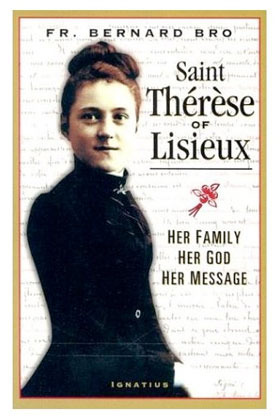
We have the opportunity to avail ourselves of much testimony about her. In
addition to the account of her life that she herself wrote, at twenty-two years
of age and completed three months before her death, her sisters, her companions,
left a series of interviews, sometimes noted day by day, that retain the sense
of immediacy of television news. Through the (apparent) banality of these
cartoon strips of piety, we always find the same reality: with Thérèse of
Lisieux, we are with someone who, in the face of the two abysses that every man
encounters, himself and God, has gone the limit, but while remaining our
companion. Thérèse is indeed the human being faced with the abyss of freedom
and the possibilities of choice-and faced with another abyss: that of an
interlocutor called God (cf. pp. 30-31).
We are still at the dawn of the third great crisis of our civilization: it is
no longer merely man confronted with his weakness (with the Greeks); no longer
merely man confronted with his guilt (with Luther, at that tragic time for
Europe, after the black plagues at the end of the Middle Ages); man today finds
himself confronted with his solitude and with the desperate quest for a meaning
to his life, confronted with the need to search for what would be an
"authentic existence", "true life", which he fears never
being able to enjoy. Among the innumerable witnesses that could be called to
the stand in this interrogation, such as Rimbaud, Van Gogh, Dostoyevsky,
Nietzsche, or Kundera, I have intentionally kept two cries, because they seem
to express the question that was Thérèse's own: "Here is my oId anguish,
right there in the hollow of my body, like a bad wound that every movement
irritates; I know its name, it is the fear of eternal solitude. And I have the
fear that there may not be any answer" (Camus).
I implored, I begged for a sign, I sent messages to the heavens: no response.
The heavens do not even know my name. I wondered at every moment what I might
be in the eyes of God. Now I knew the answer: Nothing. God does not see me, God
does not know me, God does not hear me. You see this void over our heads? That
is God. You see this hole in the earth? That is God. You see this opening in
the door? That is God again. The silence is God. Absence is God. God is the
solitude of men. [1]
Thérèse was familiar with this anguish:
When I want to rest my heart fatigued by the darkness which surrounds it by the
memory of the luminous country after which I aspire, my torment redoubles; it
seems to me that the darkness, borrowing the voice of sinners, says mockingly
to me: "You are dreaming about the light, about a fatherland embalmed in
the sweetest perfumes; you are dreaming about the eternal possession of the Creator of all these marvels; you
believe that one day you will walk out of this fog which surrounds you!
Advance, advance; rejoice in death which will give you not what you hope for
but a night still more profound, the night of nothingness." (SS 213)
For years, Thérèse sought her place in society. She had, of course, entered
Carmel, but she sought to explain to herself what the essence of it was for
her. And one day, completely radiant, she wrote:
Martyrdom was the dream of my
youth and this dream has grown with me within Carmel's cloisters. But here again,
I feel that my dream is a folly, for I cannot confine myself to desiring one
kind of martyrdom. . . . I opened the
Epistles of St. Paul to find some kind of answer. Chapters 12 and 13 of the
First Epistle to the Corinthians fell under my eyes. I read there, in the first
of these chapters, that all
cannot be apostles, prophets, doctors, etc. . . . The answer did not fulfill my
desires. . . . I continued my reading, and the Apostle explains how all
the most PERFECT gifts are nothing without LOVE... .
I finally had rest. . . . I understood that LOVE COMPRISED ALL VOCATIONS, THAT
LOVE WAS EVERYTHING, THAT IT EMBRACED ALL TIMES AND ALL PLACES....
Then, in the excess of my delirious joy, I cried out: . . . MY VOCATION IS
LOVE!" (SS 193-94)
She had chosen the feast of Pentecost 1887 to confide to her father her desire
to enter Carmel:
Everything around us corresponded with our tastes; we were given the greatest
liberty; I would say our life on earth was the ideal of happiness. . . . It was necessary to turn away from it freely.
. . . I chose the feast of Pentecost . . . . all day long begging the apostles
to pray for me, to inspire me with the right words. Shouldn't they help the
timid child who was chosen by God to be the apostle of the apostles through her
prayers and sacrifices? ... (SS 106-7)
Her father was convinced. But the others remained ... And the trip to Rome
would still not win the victory. Here is how she described her interview with
the pope:
God is making me pass through real trials before having me enter Carmel. I am
going to tell you how my visit with the pope went. . . . I did not want to
return to my place without having spoken to the pope. I said what you were
telling me in your letter The good pope is so old that one would say he is dead
He can hardly say anything. . . . I would have liked to be able to explain my
business, but there was no way. The Holy Father said simply: "If God wills
it, you will enter." (LT 36, GC 1:353)
She would have to wait. Finally, everyone would be won over by the one who
admitted: "I haven't any fear of anyone; I have always gone where I
pleased. I always slipped by them" (LC July 10, no. 8, p. 85).










A "trick of the Holy Spirit". That is the primary statement of fact.
Thérèse of Lisieux, beneath the appearance of a very nice little girl, is a
soldier, a warrior. She is the equal of the greatest among the giants God has
recommended to us, but under the most banal exterior.
In April 1932 , during a private audience with Bishop Picaud of Bayeux and
Lisieux, Pius XI thought that the image of Thérèse was in the process of being
watered down, and at that time he used the expression "a great man"
to describe her. [2] The bishop reported this to the Carmel. Which was a bit
of.a shock to her sisters, for whom Thérèse still remained a "little
angel". But it was quite in these terms that Thérèse had spoken of herself
"armed for war", taking up the call of Teresa of Avila to her
daughters to "equal strong men" (cf. LT 201, GC 2:1016-17).
She brought about a revolution. We are only at the beginning of it.
She passed through the door of Carmel at fifteen and a half years of age. Now,
Carmel is far from being "heaven". And she admitted:
Nothing near Jesus. Aridity! . . . Sleep! . . . But at least there is silence!
. .. I would be unhappy possessing [all created beauties], my heart would be so
empty! . . . It is incredible how big my heart appears to me when I consider
all earth's treasures. But when I consider Jesus, how little it appears to me!
. . . I would so much like to love Him! . . . Love Him more than He has ever
been loved! (LT 74, GC 1:499-500)
In Carmel, there was solitude, a life of
penitence, one meal per day, seven months out of twelve; little, too little,
sleep; cold (a ingle room was heated); the experience of life with those one
did not choose; the daily pinpricks. She noted with a smile: "The
refectory, which I was given charge of immediately after I received the Habit,
furnished me, on more than one occasion, with the chance of putting my
self-love in its proper place, i.e., under my feet" (SS 160) .
A Warrior
She did not allow herself to weaken: "My nature was such that fear made me
recoil; with love, not only did I advance, I actually flew" (SS 174).
I have experienced it; when I am feeling nothing, when I am INCAPABLE of praying, of practicing virtue, then is the moment for
seeking opportunities, nothings,
which please Jesus more than mastery of the world or even martyrdom suffered
with generosity. For example, a smile, a friendly word, when I would want to
say nothing, or put on a look of annoyance. (LT 143, GC 2:801)
To understand her secret as a warrior, we might go back to Nehru's admission to
Malraux: "I have three enemies: the Chinese, famine, and myself. But, of
the three, the most difficult is myself." Very quickly she learned that
nothing can be done on the path of what for her was the true life without
fighting against herself, against illusion. She, who, up to the end, had the
childish fears of a little girl, would never fear the truth, never fear to
"do the truth", as Saint John says: whether about herself, her
faults, her own limits, about her family, her community, her sisters, or one
day about death itself. She did not fear that the truth would diminish her.
Quite the contrary. It was never a malicious truth. For she found here the true
way to be victorious: by disarming, by never resisting. Instead of sidestepping
an issue, cheating, trying to justify herself, telling herself stories, she
disarmed, and she disarmed from the very moment when the truth was at issue.
Then she found something greater: a confidence that opened up freedom to her.
Her sister Céline, older than she, who entered Carmel six years after she did,
reported that one day, in watching Thérèse live, she experienced a moment of
discouragement and said to her: "Oh, when I think of all I have to
acquire." And Thérèse answered her at once: "Rather, how much you
have to lose" (CSG 23).
As the novices used to ask her how they should conduct themselves when it came
to spiritual direction, Thérèse replied: "With great simplicity, but
without relying too much on help that might fail the minute you put it into
practice. You would quickly be forced to say, like the spouse in the Song of
Songs: 'The watchmen ... took away my mantle, they wounded me; it was only by
passing a little beyond them that I found Him whom I love' [cf. Song 5:7; 3:4].
If you ask the watchmen humbly and with detachment where your Beloved is, they
will tell you. Nevertheless, most often you will find Jesus only after you have
passed beyond all creatures."
What in former times was reserved to privileged souls—Bernard of Citeaux,
Ignatius of Loyola, or John of the Cross—we find Thérèse of Lisieux
proposing for everyone: to triumph over the agony of her fate, to triumph over
fear and solitude in the face of the uncertainties of the future and of death.
Thérèse gives away the secrets of this "democratization" of the
"night of the spirit". For her, there is in each one of us an infinite,
explosive power that can conquer all fear. Thérèse is in agreement with the
prophets and the great revolutionaries of her time who were seeking this power:
this power exists, it is in each one of us. It is possible to conquer fear, all
fear: that of the future, that of limits, that of others, that of death, of
oneself. There is one condition for enjoying this infinite Power: accepting the
truth about one's incapacity.
It was fitting that, before the last council gave more explicit recognition to
the place of the laity and theorized about it, the Church had first been
anticipated, even shoved forward, by this little girl. A priest from Vietnam
wrote:
The centennial year of Saint Thérèse's birth occurs even here among the most
distant. Here, Dalat, tribus Kohos, primitive tribes of the high plains. The
mountain people of this region are haunted by fear, fear of spirits. Their
worship is centered on the blood of beasts to appease the anger of the spirits.
Say to God: "Our Father"? Consecrate oneself to his love? What a revolution!
May this year bring to our companions the tenderness of heaven. Here, the
spirit of the sun is called Siet Ngkao ("Cut-off-the-head"); the
spirit of the rainbow: Jop Mham ("Suck-the-blood", like vampires);
the spirit of thunder: Cong Co ("Cut-with-the-axe"); the spirit of
water: Kuansan ("Claw-and-eat") . . . And so on for the others:
always against man. At last,
Thérèse will speak to them of a God who is for man.
"Cut-off-the-head", "Suck-the-blood",
"Claw-and-eat". Who is without his evil spirits, and who has no need
of being delivered from fear?
ENDNOTES:
[1] Jean Paul Sartre, Le Diable et Ie bon Dieu, tableau 10, scene 4.
[2] Cf. La Semaine religieuse de Bayeux , May 1 , 1932; reprinted in La Croix of May 18, 1932.
Related Ignatius Insight Excerpts and Essays:
• St. Thérèse of Lisieux: Patron Saint of Common Sense | Stephen Sparrow
• The Beginnings | Vernon Johnson | Chapter One of One Lord, One Faith.
• Online Resources for the movie Thérèse
Fr. Bernard Bro, Dominican and doctor of philosophy, has
been a professor at the Pontifical Faculties of Saulchoir, preacher at
Notre-Dame in Paris, and
recognized by the Academie Francaise for the whole of his work. He
is considered one of the world's foremost authorities on the life and
writings of St. Thérèse.
September 30, 2013
New: "How to Share Your Faith with Anyone: A Practical Manual of Catholic Evangelization"
Now available from Ignatius Press:
How to Share Your Faith with Anyone: A Practical Manual of Catholic Evangelization[image error]
- Most Reverend Jose Gomez, Archbishop of Los Angeles
What Happens to a Church When the Members Won’t Grow Up?
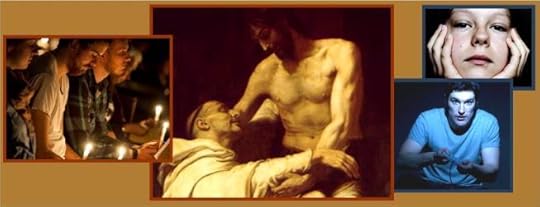
What Happens to a Church When the Members Won’t Grow Up? | R. Thomas Richard, Ph.D. | HPR
The problem for the Church is … the spiritual immaturity of men and of women in the Church, and the lack of guidance they are receiving on how to grow up to spiritual maturity as Catholic Christians.
What happens to a culture when the men refuse to grow up? What happens when no one is left to teach them how to grow up? What happens when the problem extends into the Church?
The situation in secular America is getting serious, according to a
recent book by William Bennett, The Book of Man: Readings on the Path to
Manhood. 1 Bennett wrote an article for CNN Online, 2 based on his book, and including these observations:
For the first time in history, women are better educated, more ambitious, and arguably more successful than men.
In 1950, five percent of men in the prime working age were
unemployed. As of last year (2010), 20 percent were not working, the
highest ever recorded.
The out-of-wedlock birthrate is more than 40 percent in America.
Men are less religious than ever before. According to Gallup
polling, 39 percent of men reported attending church regularly in 2010,
compared to 47 percent of women.
Ask young women about men today. … their prolonged adolescence, and
men who refuse to grow up. … “Where are the decent single men?”
Today, 18- to-34-year-old men spend more time playing video games a
day than 12- to-17-year-old boys. While women are graduating from
college and finding good jobs, too many men are not going to work, not
getting married, and not raising families.
Movies offer stories of men who refuse to grow up or to take responsibility. … Men, some obsessed with sex, treat women as toys.
Boys need to be guided through advice, habit, instruction, example, and correction, to become men.
We need to say to many young men, “Get off the video games five
hours a day, get yourself together, get a challenging job, and get
married.” It’s time for men to man up.
The problem for the Church is not merely the increasing emotional and
psychological immaturity of young men generally. More serious, although
I suspect related, is the problem of the spiritual immaturity of men
and of women in the Church, and the lack of guidance they are receiving
on how to grow up to spiritual maturity as Catholic Christians.
Pope Francis, Catechist in Action
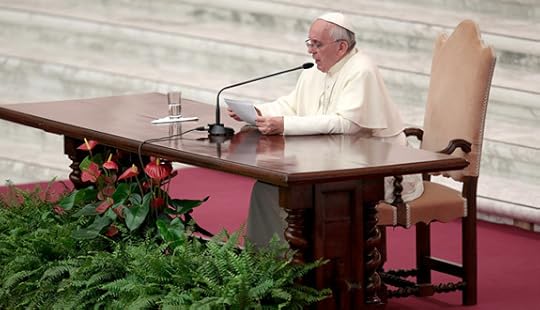
Pope
Francis, Catechist in Action | Fr. James V.
Schall, SJ | CWR
Thoughts on the Holy Father's recent address about "one of the most beautiful educational adventures"
“If a
needy person requires medicine or other help during prayer time, do
whatever has to be done with peace of mind. Offer the deed to God as
your prayer. Do not become upset or feel guilty because you
interrupted your prayer to serve the poor. God is not neglected if
you leave him for such service. One of God’s works is merely
interrupted so another can be carried out.”
— St.
Vincent de Paul, (d. 1660), Letter #2546.
“Even
if at times it (catechetical teaching) can be difficult, if it is so
much work, if it presses upon us and we do not see the results we
wish, still to educate in the faith is beautiful! The faith is
perhaps the most beautiful heritage that we can give because it makes
you grow. To help children, boys and girls, young men, women, and
adults to know and to love the Lord ever more is one of the most
beautiful educational adventures, for it comprises the Church!”
— Pope
Francis, Address
to International Catechetical Congress, September 27, 2013.
I.
“Old
Jesuits,” Pope Francis explained to the Catechetical Congress in
the Paul VI Audience Hall in the Vatican, this past Friday, always
divide their talks “into three parts.” In fact, practically
everything I have read of Pope Francis divides into three parts, like
Caesar’s Gaul. This discourse to the catechists is no exception. In
his recent interview with the Jesuit editor, the Pope also recalled
the famous Jesuit advice to learn to “contemplate in action.”
Though he does not neglect times of prayer and solitude, as we see in
this discourse, still Pope Francis seems, like St. Vincent de Paul,
to be a man eager for action, for getting things moving.
In his
exhortation to the catechists, Pope Francis continues his almost
relentless attack on those who think that an office or a status is
sufficient. Just to have the name or diploma of being a catechist (or
a professor, or a vicar, or a bishop) is not enough. “To be a
catechist is a vocation.” What really counts is our personal
“testimony,” not our titles. This witness is what people watch
for. Francis cites Benedict XVI: “The Church does not increase by
proselytism but by attraction,” by the attraction of those lives
that live the faith. “To be a catechist means to give testimony to
the faith.” Francis also cites Francis of Assisi who told his
brothers: “Preach, always preach the Gospel, and, if necessary,
also with words.” That is, our best “preaching” is not with
words but with the witness of our lives. People see the Gospel first
in the way we live. That is where they “read” the Gospel.
Obviously,
Francis puts a great responsibility on every one who has the
faith—the responsibility of passing it on. To be a catechist
requires love, always one that is “stronger.” This love comes
from Christ. It is a “gift.” We do not concoct it by ourselves.
If we think we can, we depart from the love that Christ gives to us.
“What does it mean to be a catechist?” the Pope asks. What does
it mean for you, “even for me?”
First of
all, to go forth from Christ means to be “familiar” with Him.
September 28, 2013
Lazarus, the Rich Man, and the Sin of Pride
A Scriptural Reflection on the Readings for Sunday, September 29, 2013 | Carl E. Olson
Readings:
• Am 6:1a, 4-7
• Ps 146:7, 8-9, 9-10
• 1 Tm 6:11-16
• Lk 16:19-31
As we hear the various parables from
the Gospel of Luke it is good to keep two things in mind. First, the
context of these teachings, which were given by Jesus as he made his
way up to Jerusalem to “be delivered into the hands of men” (Lk.
9:44) and enter into his Passion. That journey was not just a
physical journey, but also a sign of obedience to the will of the
Father, a concrete expression of perfect humility and self-gift.
Secondly, his parables and discourses
given during the journey were not haphazard or random in nature, but
form a cohesive and focused whole. They are like different paths
leading to the same place and shedding light on the same event:
Jesus’ death on the Cross for the salvation of mankind. Some of
them were meant specifically for the disciples; others for the crowds
following Jesus; still others for the Pharisees and other religious
leaders.
Between last week’s reading of the
parable of the dishonest steward (Lk. 16:1-15) and today’s parable
is a little bridge of five verses (16:14-18). That passage states
that the Pharisees—“who were lovers of money”—had heard Jesus
say, “You cannot serve God and mammon”, and had sneered at him.
Jesus then said to them, “You justify yourselves in the sight of
others, but God knows your hearts; for what is of human esteem is an
abomination in the sight of God.”
This sets up the parable of the rich
man and Lazarus, a story sometimes interpreted solely as a
renunciation of greed and a call to treat the poor with justice. That
interpretation is, of course, both correct and important. Today’s
reading from the prophet Amos takes up the same issue, directing a
curse toward the complacent wealthy who stuff themselves with rich
meat while starving themselves spiritually. And the first half of the
parable (vs. 19-26) is directed toward the same sort of opulent
self-indulgence and gluttonous revelry.
But there is more to it, for Jesus took
what was quite possibly a well-known motif—a rich man descending
into Hades—and suddenly, as the saying goes, brought it home with
an unexpected epilogue. The rich man begs Abraham to send Lazarus to
warn his five brothers so they might escape eternal torment. Who are
the five brothers? In the immediate context, they are the Pharisees,
the ones who have and know the law of Moses and the prophets and yet
fail to pursue the will of God and die to pride.
St. Jerome, commenting on this passage,
said the rich man is not accused of greed, theft, adultery, “or, in
fact, of any wrongdoing. The evil alone of which he is guilty is
pride.” Pride, says St. Thomas Aquinas in his treatise on evil,
signifies an intentional contempt of God. Every sin, in fact, is
infected to some degree by pride. The Catechism explains that
“hatred of God comes from pride. It is contrary to love of God,
whose goodness it denies…” (par. 2094).
Pride destroys love for God and love
for others; it seeks only itself and its desires, without thought for
tomorrow or the afterlife. The Pharisees, as Abraham tells the rich
man, have Moses and prophets. They, more than anyone else, had no
excuse for being prideful and refusing to repent. But they failed to
heed John the Baptist’s warning about believing that because
Abraham was their father, they had no need for repentence (Lk. 3:8).
Jerome, providing a spiritual
interpretation, likens the five brothers to our five physical senses.
Pride often comes through physical, sensual pleasures; materials
things meant for our good can become our masters. “Blessed are you
who are poor,” Jesus taught in the Sermon on the Mount, “But woe
to you who are rich…” Regardless of income and social status, all
Christians must pursue a spirit of poverty, for without it we cannot
take up the cross, die to sin, and enter eternal beatitude.
(This "Opening the Word" column originally appeared in the September 26, 2010, edition of Our Sunday Visitor newspaper.)
Al Kresta: Missionary Looking Inward, Then Outward
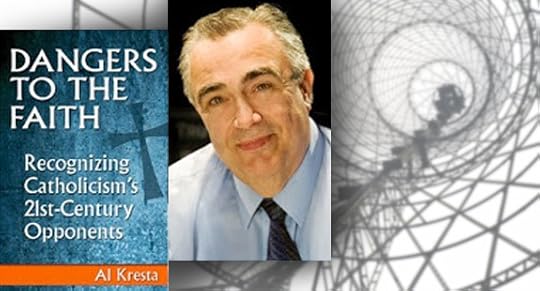
Al
Kresta, Missionary Looking Inward, Then Outward | John Burger | CWR
Outlining today’s "Dangers to the Faith", author and radio host urges Church renewal and rebuilding
What
will it take to save Western culture? What will it take to turn
things around in an America that seems to have turned its back on its
Judeao-Christian foundations?
Al
Kresta doesn’t see it happening—at least not until the Church
changes first.
Kresta,
the long-time host of the popular “Kresta in the Afternoon” talk
show, is the author of Dangers
to the Faith: Recognizing Catholicism’s 21st-Century
Opponents
(OSV, 2013). Though the new book focuses largely on external
threats—cults, scientific materialism and atheism, historical
revisionism, secularism and consumerism—Kresta also touches on
internal dangers, such as the complacency of some Christians. He
concludes the 303-page book with a call to personal holiness.
“Often
a life well lived can do more to illustrate the truth—‘adorn the
doctrine,’ as St. Paul tells Titus—than the most brilliant
words,” he writes. “The lives of the saints, but especially your
becoming a saint, may be the most neglected tool in the
missionary/apologist’s work bucket.”
In
this Year of Faith called by Pope Benedict XVI, and in the wake of
the 2013 conclave, in which a new Pope’s name echoes the call to
“rebuild My Church,” Kresta and Ave Maria Radio are inviting
Catholics to “Rebuild the Church, Bless the Nation.”
One
must precede the other.
“In
the late ‘70s I think there was a window of opportunity for
Christians to potentially change the culture,” Kresta said in a
wide-ranging interview with Catholic
World Report. “I think
that opportunity’s passed. I think the window has been shut. Right
now we need to build the Church. I don’t want to say ‘forget the
nation,’ because we should continue to oppose same-sex so-called
marriage. We have to continue to work for the protection of unborn
life. We have to continue to work to make sure the poor have adequate
educational opportunities.... The Church itself needs to be rebuilt,
and that’s what John Paul II was talking about with the new
evangelization. Benedict, I think, was suggesting the same thing. And
I think Francis is … about a more authentic, consistent, coherent
Church.”
Kresta
said his next book might be about how Catholics “undermine their
own witness in the world, how we as a community are sending real
mixed signals. We’re not bearing real truthful witness to who
Christ is.”
Long
and Winding Road
At
62, Kresta has spent a lifetime searching for that Christ, coming to
know him better and finding ways to make him better known. He regards
himself primarily as a missionary, whether he is on air, producing
Catholic programming, organizing conferences, writing books, or
simply being a husband, father, parishioner and neighbor.
“Al
Kresta is a broadcaster, journalist and author who is, first of all,
a missionary,” says his bio page at Ave
Maria Radio,
where he serves as president and CEO.
“The
point of the show and of Ave Maria Radio is to make more and better
Catholics,” said Nick Thomm, executive producer and news director
of “Kresta in the Afternoon.”
It
was not always thus with Albert Kresta. His early life and detours
through drugs, the New Age movement and other distractions are
documented in Surprised by
Truth: 11 Converts Give the Biblical and Historical Reasons for
Becoming Catholic (ed.
Patrick Madrid, 1994, Basilica Press).
September 27, 2013
Shedding Light on Misunderstood Knights

Shedding Light on
Misunderstood Knights |
Vincent Ryan | Catholic World Report
Two new books about
the Templars and the Hospitallers separate historical fact from
popular fiction
Michael Haag, The
Tragedy of the Templars: The Rise and Fall of the Crusader States
(Harper: New York, 2013) 448 pp, paperback, $16.99
Jonathan Riley-Smith,
The Knights Hospitaller in the Levant, c. 1070-1309 (Palgrave
Macmillan: New York, 2012) 352 pp, hardcover, $105.00
One of the most
commonly perpetuated myths about the First Crusade is that
participation in the campaign was primarily driven by economic
motivations, particularly by younger sons who had minimal inheritance
prospects and thus regarded the crusade as a promising land-grab.
Specialists in this field have eviscerated this dubious premise. For
instance, computer-based prosopographical studies of the first
crusaders have shown that the expedition was actually largely
comprised of the oldest sons, who had access to the family’s assets
which were essential to financing their participation in the
crusade.
The behavior of the
first crusaders further illustrates how deeply flawed this notion
that participants were chiefly interested in acquiring lands. After
capturing Jerusalem in the summer of 1099, most of the crusaders
venerated the holy sepulcher and returned to Europe. Manpower
shortages were one of the most pressing problems for the Latin
Christians who remained in the region. The emergence and growth of
the Templars and Hospitallers was one response to this mounting
crisis. Two recent books on these respective military orders
highlight the central role that each played in the defense of the
crusader states in the twelfth and thirteenth centuries.
The Origins of the
Templars
The Tragedy of the
Templars: The Rise and Fall of the Crusader States by Michael
Haag at first glance might seem like another entry in the publishing
subgenre of Templar-related nonsense.
The somewhat sensationalist title is likely a reflection of
marketing concerns, as the book itself is a fairly sober and
thought-provoking study. This is the second tome that Haag has
written on the order, and his ease and confidence in discussing
various aspects of the Templars is one of the strengths of the book.
Though the loss of the Templar archives has clouded our
understanding of the genesis of the order and its early history, Haag
pieces together a pretty reasonable account of the first two decades
of the Templars. In the aftermath of the First Crusade, Christian
control of Palestine was far from secure as Muslim bands raided the
countryside and harassed the steady stream of vulnerable pilgrims on
the open roads. Around 1119, Hugh of Payns and several other
companions started a group that would be dedicated to protecting
Christians who were visiting the holy sites. Haag wrongly claims
that Hugh was a veteran of the First Crusade, but he rightly
emphasizes how a massacre around Eastertide of 1119 of more than
three hundred European pilgrims who were visiting holy sites outside
of Jerusalem was undoubtedly a catalyst in the founding and
acceptance of Hugh’s group. Hugh and his comrades were aided
considerably in their endeavor by the support of Baldwin II of
Jerusalem. Most significantly, the king provided them with a
headquarters which was thought to have been the location of the
Temple of Solomon and it was from this connection that these knights
would ultimately derive their name.
September 26, 2013
Carl's Cut's (For the End of Summer, Start of Fall)
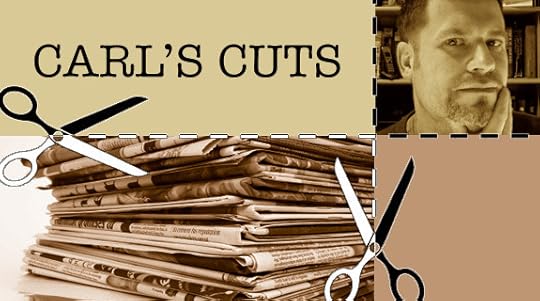
Carl's Cut's (For the End of Summer, Start of Fall) | Carl E. Olson | CWR blog
Commentary on matters big, small, light, heavy, ecclesial, secular, musical, and otherwise.
• A
friend, whose alma mater is the University of Notre Dame, wrote me
this morning: "Apparently, Pope Francis gave some crazy
interview in which he implied that Catholics should not be
'obsessed' with ND football. A sure sign the end of all things
is nigh." He did not send a link to the original comment in
Italian, so I cannot verify.
• It
is rumored that the word of the month for September is "credibility".
It's not clear how credible those rumors really are.
• In
recent decades, there have been serious cuts to the funding of good,
sharp satire. One reason is that it's difficult to satirize a culture
that would make most forays into the satirical arts look like a pale
imitation of the madness that holds sway. A recent example is the
case of a former British soldier who is now, well, something else
altogether:
A
former trained soldier has swapped her Territorial Army beret for a
veil and become Britain's first transgender Muslim woman. Lucy
Vallender used to be called Laurens and says she is finally 'true to
herself' after a sex change three years ago. The 28-year-old is now
married to a Muslim man she met on an online dating site, but he did
not know she was once a man when they wed.
No,
of course he didn't. Because that would likely exhibit some sort of
"gender bias", right? Except I doubt that was part of the
equation. But if this story were an equation, we'd have to use the
"≠" sign as nothing adds up.
• Speaking
of changes, the former Crystal Cathedral is undergoing many
substantial changes:
The
Crystal Cathedral was to [Robert] Schuller what Graceland was to
Elvis. Now it has been bought by the Roman Catholic Diocese of
Orange, which has long coveted having a cathedral that sat at the
center of its vast footprint of 1.2 million Catholics.
The
name has already been changed to the Christ Cathedral. But the work
of liturgical consultants, priests and architects to transform a
temple so closely identified as a symbol of Schuller's sunny,
uniquely Southern Californian theology into one that conforms to the
traditions of the Roman Catholic Church has just begun.
"The
exterior will always be the Crystal Cathedral, at least for a while,"
said Duncan Stroik, a professor of architecture at Notre Dame and
editor of the publication Sacred Architecture Journal. "Catholic
on the inside, but kind of Protestant on the outside."
Those
who have taken on the project recognize that their assignment is a
intimidating one, but they also have faith: They can turn the Crystal
Cathedral into the Christ Cathedral.
Read
the entire story on the LA
Times
site. It is heartening to read the comments by Dr. Stroik, who is
leading the way in the revival of great Catholic architecture, as
evidenced in part by his recent book, book, The
Church Building as a Sacred Place: Beauty, Transcendence, and the
Eternal,
which was reviewed
for CWR by Dr. Amanda Clark earlier this year.
• Is
Hollywood out of ideas? Has it tapped out when it comes to fresh
cinematic adventures for the masses? I'd say the answer is tilting
hard toward “Yes” when there
is a remake of Left Behind currently in the works.
And it stars Nicholas Cage. Yes, the Apocalypse is upon us, and it
will cost you $10.00 to experience for two hours.
• In
light of recent events and the reaction of some, I propose that
Matthew 16:18 (New Jerusalem Translation) be re-written as follows:
So
I now say to you: You are Peter and on this rock I will build my
community. And the gates of the underworld can never overpower it, up
and until a twenty-first century pope gives a lengthy interview which
fractures the very foundation of said community and destroys the
faith of millions and plunges the world into darkness and confusion
not seen since said pope's comments about atheism a few months
earlier.
A
bit wordy, I suppose, but I'm sure the original Greek will flow like
honey. (And, please, spare me the angry e-mails. Just leave angry comments. We need more comments. I get paid by the comment.)
• Clueless
Cut of the Week comes courtesy of mushy, trendy, lefty
“Evangelical” author and know-it-all, Brian McClaren: “We
have a Catholic priesthood more concerned with keeping women out of
the priesthood as the world is destroyed by carbon gases. … We have
evangelicals with the audacity to say that homosexual people are
ruining marriage. I think anyone who says that should be laughed off
the stage. Heterosexual people do that on their own, thanks.” No
word if McClaren and Jody Bottum are working on a book together yet.
• I enjoy reading nearly
anything by the Anglican Scripture scholar N.T. Wright, and his
recent interview with Christianity Today about the Psalms
is not exception:
September 24, 2013
The Mother of Christ comes alive on the big screen
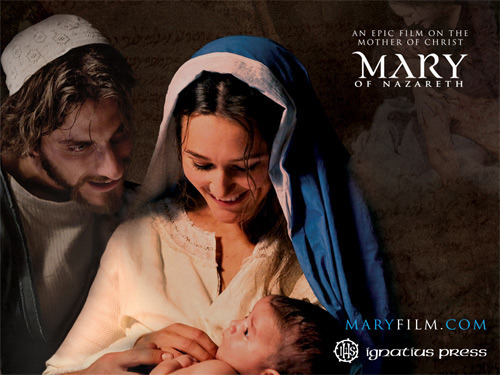
Ignatius Press brings stunning film on Mary exclusively to North America
SAN FRANCISCO, Sept. 24, 2013 – Mary, the Mother of Jesus Christ is revered throughout the world. However, her amazing life has not been featured on the big screen — until now.
Ignatius Press will release MARY OF NAZARETH, a major motion picture on the life of Our Blessed Mother, for sponsored theatrical screenings across the country beginning in October. The North American premiere will take place in San Francisco on October 11 featuring the stunning actress who portrayed Mary in the film, Alissa Jung, and well-known Marian expert Father Donald Calloway, MIC.
“Ignatius Press is very excited to bring to the silver screen this incredible new epic feature film on Our Lady, MARY OF NAZARETH,” said Ignatius Press Director of Sales and Marketing Anthony Ryan. “Produced by the same European studios who have made such other high-quality films with profound spiritual depth like Restless Heart: The Confessions of Augustine, Pope John Paul II, Bakhita: From Slave to Saint and Padre Pio: Miracle Man, this powerful film on the life of Mary will provide deep inspiration for all who see it on the big screen. Ignatius is very happy to follow in the wake of the theatrical sponsored screening success of Restless Heart to work with faith-filled movie fans everywhere to bring this amazing film on Mary to theaters in their neighborhoods, providing a unique opportunity for inspiring entertainment, strong evangelization and significant fundraising.”
Pope Emeritus Benedict XVI screened the movie in the Apostolic Palace in 2012, and was touched by the portrayal of Mary so movingly revealed on film. He commented that “it is not easy to characterize the figure of any mother, because the riches of the maternal life are difficult to describe, but this is even more challenging when it comes to the Mary of Nazareth, who is the mother of Jesus, the Son of God made man.”
Unlike many faith-based films that open in limited release around the country and often don’t make it to cities and towns with significant interest, MARY OF NAZARETH is available for showing anywhere in North America. Individuals, parishes, church groups or other organizations can arrange to bring this epic film to their towns immediately. There are currently close to 250 screenings in various stages of planning. Interested groups and individuals work with local theaters and other venues to rent a screen, and Ignatius provides a copy of the film with a complete promotional kit for an affordable fee.
An exclusive trailer of the film is available online now at www.MaryFilm.com. For more information or interviews, please contact Kevin Wandra (404-788-1276 or KWandra@CarmelCommunications.com).
To bring MARY OF NAZARETH to a theater in your area beginning Oct. 1, please inquire via email through Carmel Communications at screenings@carmelcommunications.
Ignatius Press will host the MARY OF NAZARETH premiere at 7 p.m. PT Friday, Oct. 11 at the AMC Metreon 16, 135 4th St #3000, San Francisco, CA 94103. Alissa Jung, the German actress who stars as Mary in the film, and Fr. Donald Calloway, author of UNDER THE MANTLE: Marian Thoughts From a 21st Century, who has endorsed the film, will attend the premiere, and be available for a Q-and-A following a screening of the movie.
About the Film
MARY OF NAZARETH vividly captures the essence of Mary’s profound faith and trust in God amidst the great mysteries that she lived with as the Mother of the Messiah, her compassionate humanity and concern for others, and the deep love that she and Jesus shared for one another. This movie underscores her special role in God’s plan for our redemption, her unique relationship with Christ, and the tremendous suffering that she endured in union with his passion and death, as well as her serene joy at his Resurrection.
Filmed in Europe, this major new epic film on the life of Mary is the first full-length feature movie on the story of this incredible woman to be shown in theaters. It was shot in English in high definition.
MARY OF NAZARETH is directed by acclaimed European film director Giacomo Campiotti (BAKHITA, DOCTOR ZHIVAGO, ST. GIUSEPPE MOSCATI) and written by Francesco Arlanch (RESTLESS HEART, PIUS XII, POPE JOHN PAUL II). The original music score was written by Guy Farley.
Faith According to Pope Francis
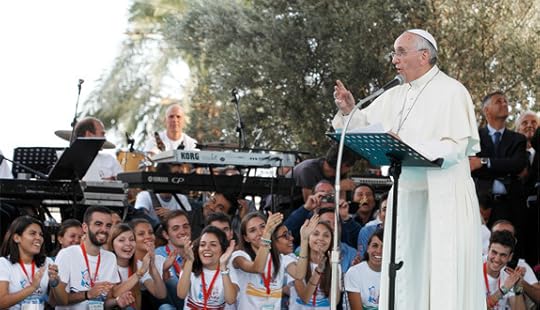
Faith
According to Pope Francis |
Msgr.
Daniel B. Gallagher | Catholic World Report
It’s
not a banana smoothie, but a transforming encounter with Jesus
Christ, here and now
Papa
Francisco is full of surprises. You never know what’s going to come
out of his mouth, but it often has something to do with what goes in.
“Buon
pranzo”
(have a good lunch) has become his signature sign off. This summer,
he shook things up in Rio by insisting that faith is not a banana
smoothie. “Please, do not put your faith in Jesus Christ in a
blender. You can have orange smoothies, apple smoothies, banana
smoothies, but please, do not gulp down a ‘faith-shake.’ Faith is
a whole; you can’t mix it up in a blender.”
So
if faith is not a banana smoothie, what is it? September has provided
plenty of answers.
Francis’s
faith
Even
though the 13th
of September marked the sixth-month anniversary of Francis’s
election to the papacy, it was not the most important anniversary of
the month. That occurred on September 21st,
the Feast of Saint Matthew, when Francis commemorated the sixtieth
anniversary of his call to the priesthood. Francis recounted the
events of that extraordinary day to young people in Cagliari this
past Sunday. Those events took place after the seventeen-year-old
Jorge made a confession and talked with a priest at the parish of San
Jose in Buenos Aires. His episcopal and now papal motto – miserando
atque eligendo –
recalls the experience with words taken from the Venerable Bede and
appearing in the Office of Readings on the Feast of Saint Matthew.
Quoting from Paul’s First Letter to Timothy, Bede writes: “‘For
Christ
Jesus came into the world to save sinners. And I am the foremost of
sinners; but I received mercy for this reason, that in me, as the
foremost, Jesus Christ might display his perfect patience for an
example to those who were to believe in him for eternal life.’ Thus
Jesus saw the tax collector, and since
he saw him by having mercy and by choosing, he said to him, ‘follow
me.’ But to follow means to imitate. ‘To follow’ does not mean
so much by foot as by one’s way of life (executione
morum).”
In
the recent interview published in the Jesuit publication Civiltà
Cattolica, Francis
points out the difficulty in translating the Latin gerund miserando.
Perhaps
“pitying” is close in English, but even that fails to catch the
import of the Lord’s infinite power to forgive and its inextricable
connection with “calling.” Where language falls short, Francis
uses an image. He explains that Jesus’ outstretched finger in
Caravaggio’s The
Call of Matthew
points at him in the same way it points at Matthew. “I am a sinner
upon whom the Lord has cast His gaze,” Francis says. The same sense
of sinfulness overcame him the moment he was elected to succeed
Benedict XVI. When the tally came in, he calmly whispered, “Peccator
sum, sed super misericordia et infinita patientia Domini
nostri
Jesu Christi confisus et in spiritu penitentiae accepto”
(I am a sinner, but relying on the mercy and infinite patience of our
Lord Jesus Christ, in a spirit of repentance, I accept).
Francis’s
interview with fellow Jesuit Fr. Antonio Spadaro, S.J., gives us a
unique insight into not only his rich theology of faith, but his
personal experience of faith.
Carl E. Olson's Blog
- Carl E. Olson's profile
- 20 followers



